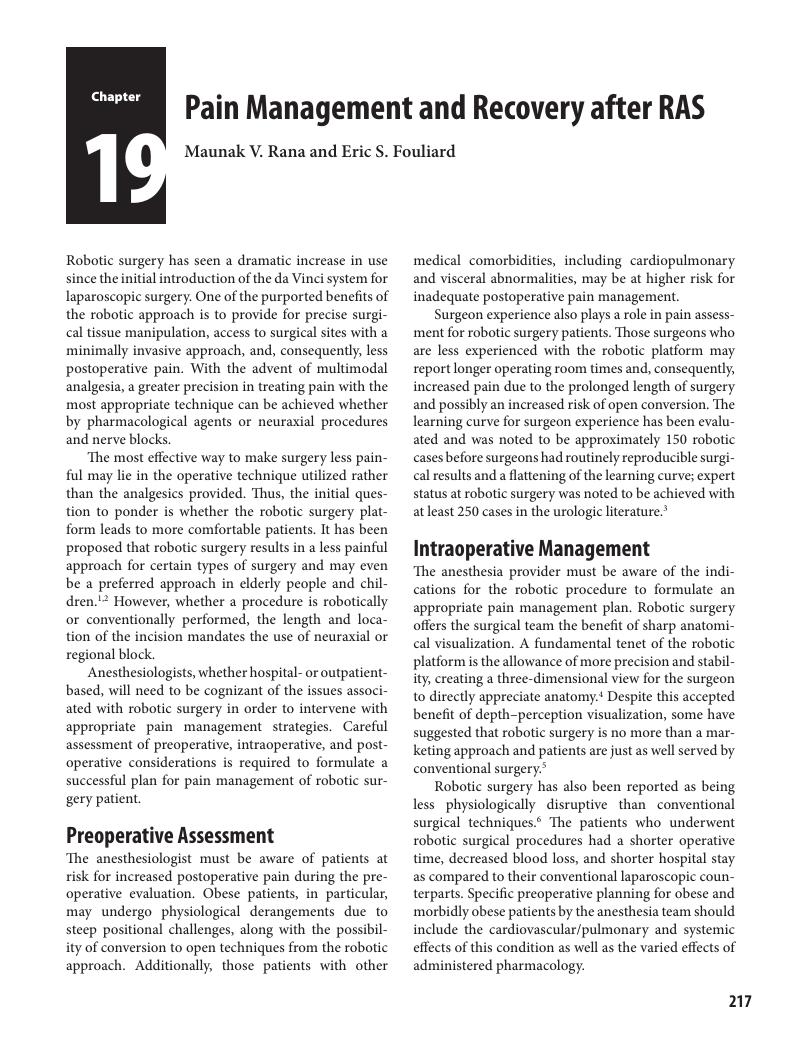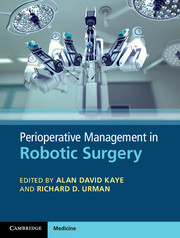Book contents
- Perioperative Management in Robotic Surgery
- Perioperative Management in Robotic Surgery
- Copyright page
- Dedication
- Contents
- Contributors
- Preface
- Introduction
- 1 Historical Overview of Robot-Assisted Surgery
- 2 Credentialing for Robotic Surgery
- 3 Robotic Technology
- 4 Physiologic Effects of Pneumoperitoneum and Positioning
- 5 Considerations in Patients with Comorbidities, Pregnant and Pediatric Patients
- 6 Anesthetic Considerations for Robotic-Assisted Surgery
- 7 General and Colorectal Robotic Surgery of the Abdomen and Pelvis
- 8 Gynecology Robotic Surgery
- 9 Robotic Urological Surgery
- 10 Anesthetic Considerations in Robotic Cardiac Anesthesia
- 11 Robotics in Thoracic Surgery 1
- 12 Robotics in Thoracic Surgery 2
- 13 Transoral Robotic Surgery
- 14 Robotic Technology in Neurosurgery
- 15 Organ Transplant and Robotic Surgery
- 16 Surgical Considerations for Organ Transplantation and Robotic Surgery
- 17 Fetal Surgery and Robotic Surgery
- 18 Perioperative Complications of Robotic Surgery
- 19 Pain Management and Recovery after RAS
- 20 Technical Skills Training and Simulation
- 21 Understanding the Market Forces and Opportunity Costs of Robotic Surgery
- 22 The Past, Present, and Future of Robotics
- Index
- References
19 - Pain Management and Recovery after RAS
Published online by Cambridge University Press: 11 August 2017
- Perioperative Management in Robotic Surgery
- Perioperative Management in Robotic Surgery
- Copyright page
- Dedication
- Contents
- Contributors
- Preface
- Introduction
- 1 Historical Overview of Robot-Assisted Surgery
- 2 Credentialing for Robotic Surgery
- 3 Robotic Technology
- 4 Physiologic Effects of Pneumoperitoneum and Positioning
- 5 Considerations in Patients with Comorbidities, Pregnant and Pediatric Patients
- 6 Anesthetic Considerations for Robotic-Assisted Surgery
- 7 General and Colorectal Robotic Surgery of the Abdomen and Pelvis
- 8 Gynecology Robotic Surgery
- 9 Robotic Urological Surgery
- 10 Anesthetic Considerations in Robotic Cardiac Anesthesia
- 11 Robotics in Thoracic Surgery 1
- 12 Robotics in Thoracic Surgery 2
- 13 Transoral Robotic Surgery
- 14 Robotic Technology in Neurosurgery
- 15 Organ Transplant and Robotic Surgery
- 16 Surgical Considerations for Organ Transplantation and Robotic Surgery
- 17 Fetal Surgery and Robotic Surgery
- 18 Perioperative Complications of Robotic Surgery
- 19 Pain Management and Recovery after RAS
- 20 Technical Skills Training and Simulation
- 21 Understanding the Market Forces and Opportunity Costs of Robotic Surgery
- 22 The Past, Present, and Future of Robotics
- Index
- References
Summary

- Type
- Chapter
- Information
- Perioperative Management in Robotic Surgery , pp. 217 - 227Publisher: Cambridge University PressPrint publication year: 2017



